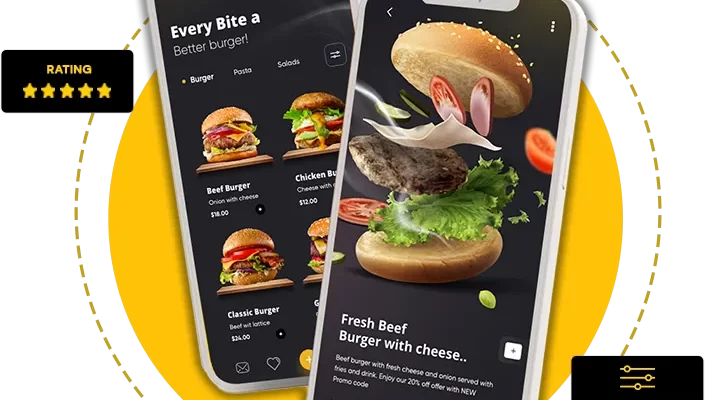
The rise of food delivery apps has reshaped the dining industry, making it easier than ever for consumers to order meals from their favorite restaurants. Apps like Postmates have become a standard in the food delivery industry, setting a high bar for convenience, speed, and customer satisfaction. If you’re considering developing a similar app, this guide will walk you through the essential steps involved in food delivery app development, from features and technology stack to cost breakdown and key strategies for success.
1. Understanding the Postmates Business Model
Before diving into food delivery app development services, it’s essential to understand the business model behind Postmates. Unlike many other food delivery apps, Postmates operates on an on-demand delivery model, allowing users to order not just food but also groceries, electronics, and other essentials. It connects users with local couriers who can deliver products from stores or restaurants within a set radius.
Your app should provide similar flexibility if you aim to replicate the success of Postmates. Along with food delivery, consider adding multiple delivery categories to expand your target audience.
2. Key Features of a Successful Food Delivery App
To create an app like Postmates, you must focus on key features that enhance user experience and streamline the delivery process. These features ensure customer retention and a smooth workflow for your app.
2.1 User Registration and Profiles
The first step for any app is user registration. Allow users to register via social media, email, or phone numbers. Profiles should store essential information, such as address, payment options, and order history.
2.2 Restaurant Listings and Menus
A detailed list of participating restaurants is a must for your app. Integrating restaurant information, menus, pricing, and customer reviews ensures that users can browse and make informed decisions before ordering.
2.3 Order Tracking
Real-time tracking is one of the most critical features in any food delivery app. Your app should allow users to track their orders from the moment they place them to delivery. GPS-enabled tracking ensures transparency and builds trust.
2.4 Multiple Payment Gateways
Make payments easy for your customers by integrating multiple payment methods, including credit/debit cards, wallets, and even cash on delivery. Ensure your app supports secure payment gateways to protect user data.
2.5 In-app Chat and Support
Providing real-time customer support via chat can enhance user experience. In-app chat features allow customers to communicate with the delivery person or customer support in case of delays, wrong orders, or other issues.
2.6 Ratings and Reviews
Allow users to rate restaurants, delivery personnel, and their overall experience. These ratings and reviews will help build credibility for your platform and ensure quality service.
2.7 Push Notifications
Push notifications keep users updated about their orders, special offers, and new restaurant listings. They also help re-engage users who haven’t ordered for a while.
3. The Technology Stack for a Food Delivery App
To successfully build an app like Postmates, you need a robust technology stack. This includes:
- Frontend Development: Frameworks like React Native or Flutter for building responsive, cross-platform apps.
- Backend Development: Technologies like Node.js, Python, or Ruby on Rails for creating the server side of the application.
- Database Management: SQL databases like MySQL or NoSQL databases like MongoDB to store user data, restaurant information, and order histories.
- APIs: Integration of third-party APIs for payment gateways, GPS services, and real-time communication.
- Cloud Hosting: AWS or Google Cloud for app hosting and scaling based on user demand.
Partnering with a custom Android app development service can ensure the app’s scalability, performance, and smooth integration of these technologies.
4. Cost to Develop a Food Delivery App Like Postmates
The cost of food delivery app development depends on various factors, including the features, platform (iOS, Android, or both), and the region where you’re hiring developers. Here’s a basic cost breakdown:
4.1 Basic Features:
For an app with essential features like user registration, restaurant listings, and basic payment integration, expect the cost to be around $20,000 to $40,000.
4.2 Advanced Features:
Adding features like real-time GPS tracking, in-app chat, and push notifications can increase the cost to $50,000 to $100,000.
4.3 Custom Features and Scalability:
If you aim for custom features, integrations, and scalability (like Postmates), the cost can go beyond $100,000, especially if you hire top-tier food delivery app development services.
5. How to Choose the Right Development Partner
Building an app like Postmates requires partnering with the right food delivery app development company. Here’s how to choose the right partner:
5.1 Experience in Food Delivery Apps
Ensure your development partner has experience in building similar apps. Review their portfolio to assess the quality of their previous projects.
5.2 Expertise in Android Development
Since Android holds a significant share in the mobile market, ensure the developers specialize in custom Android app development services to cater to this audience.
5.3 Post-Launch Support and Maintenance
Once the app is live, it will require regular updates and maintenance. Opt for a company that offers ongoing support to handle bug fixes, new features, and performance optimizations.
5.4 UI/UX Design Expertise
User experience is critical for app success. Work with developers who can create an intuitive, aesthetically pleasing design for your app.
6. Marketing and Monetization Strategies for Your Food Delivery App
Once the app is ready, focus on marketing and monetization strategies to make your app profitable.
6.1 Freemium Model
Offer basic services for free and premium features via subscription or one-time payments. Premium services could include faster deliveries, exclusive offers, or access to certain restaurants.
6.2 Delivery Charges
Charge users for deliveries based on distance, time, or demand (surge pricing). Ensure these charges are transparent and fair.
6.3 Advertising
Allow restaurants to promote their listings on your app through paid advertisements, increasing your revenue and their visibility.
6.4 Partnerships with Restaurants
Negotiate commissions with restaurants for each order made through your app. This is a win-win as it boosts restaurant sales while providing revenue for your app.
Conclusion
Building a food delivery app like Postmates requires a thorough understanding of the business model, technology stack, and user expectations. Whether you’re starting from scratch or upgrading an existing app, partnering with a food delivery app development company that offers custom Android app development services will be key to your success. By focusing on scalability, performance, and user experience, your app can stand out in a competitive market, delivering value to both customers and restaurants.








